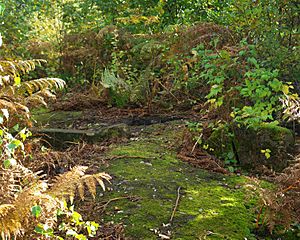Thynghowe facts for kids
Thynghowe was a very important meeting place from the Viking Era. It was an open-air assembly, or "thyng," located in Sherwood Forest, Nottinghamshire, England. For a long time, Thynghowe was lost to history. Then, in 2005, a husband and wife team, Lynda Mallett and Stuart Reddish, rediscovered it. They were local history fans! Thanks to their work and more research, Thynghowe is now officially recognized by the Historic England Archive.
Contents
What is Thynghowe?
Thynghowe was a special outdoor meeting place used by people long ago. It was a place where communities gathered to discuss important matters. They would solve problems and make decisions together. Think of it like an old-fashioned town hall meeting, but outside!
Where is Thynghowe Located?
This historic site is found among the old oak trees in a part of Sherwood Forest called the Birklands. Sherwood Forest is famous for the legends of Robin Hood. Experts believe Thynghowe might also help us understand the old borders of the ancient Anglo-Saxon kingdoms. These kingdoms were called Mercia and Northumbria.
When Was Thynghowe Used?
In 2011, a group called English Heritage looked closely at the site. They confirmed that the name "Thynghowe" was used for this spot in old records from 1334 and 1609. This shows it was an important place for many centuries. People came here to settle arguments and sort out community issues.
What Does the Name "Thynghowe" Mean?
The name "Thynghowe" comes from the Old Norse language. This was the language spoken by the Vikings. Even though the name is Norse, the site itself might be even older. It could even date back to the Bronze Age!
Understanding "Howe"
The word howe comes from the Old Norse word haugr. This word means "mound." When you see "howe" in a place name, it often means there's an ancient burial mound nearby.
Understanding "Thyng"
The word "thyng" (or "thing") refers to a governing assembly. This type of meeting was common among Germanic peoples and was also adopted by some Celtic groups. These assemblies were made up of the free people from the community. They were led by "lawspeakers" who knew all the rules and traditions.
Images for kids



